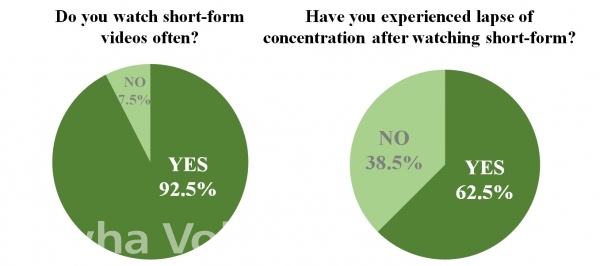No more than a minute long, the video ends in a flash before swiftly moving onto the next one. This is called a short or a short-form video, a form of content that contains and shows off everything it has to offer within an average of 15 to 60 seconds. After watching a few such videos on autoplay, it is easy to lose track of how much time has passed. Ewha Voice looked into when and how this form of content first appeared, along with its benefits and problems.
Short-form trend from the view of top domestic short-form company

SOON Ent is the nation’s No. 1 MCN company with more than 940 million followers in total based on the global short video platform, TikTok. MCN, short for MultiChannel Network, supports and manages newly-emerged internet and social media influencers and broadcasters, similar to how entertainment agencies exist for traditional entertainers.
Ranking the number one big domestic MCN company, SOON Ent manages 27 creators with more than 10 million followers and processes 10 exclusive creators amongst the top 20 in South Korea.
When short-form content was first brought on the stage by TikTok in 2017, TikTok sought a partnering company to make its inroads into the Korean market. Growing rapidly and looking for a domestic partner for the greater growth of their short-form services, SOON Ent was suitable for them to meet their objectives. Park Changwoo, who founded SOON Ent in 2016, was attracted to the feature of a short-form video that could quickly convey both meaningful message and amusement in an average of 15 seconds and began the partnership with TikTok.
“Short-form content is gaining popularity among the current generation who want to get fast and diverse information, as it delivers short and condensed messages by the introduction and conclusion of the storyline, rather than having all four steps in composition shown by ordinary videos,” Park said.
Park added that the high penetration rate of smartphones also played a part in the current popularization of short-form content. He explained that it is now becoming a new form of recreation because it is easy to both access and produce videos without expensive filming equipment or editing technology, unlike long videos on YouTube.
Since its foundation and partnership with TikTok, SOON Ent has been showing its overwhelming influence in the short-form market by producing the first creator with one million followers in South Korea and executing advertisements from leading companies.
Park aims to make SOON Ent the world’s number one global short-form business company recognized worldwide. He believes in the infinite attractiveness and numerous factors of shortform content that draw people worldwide into the short-form trend, and considers it a pioneer in developing the new Korean wave market.
New critical thinking skills are required for the new trend

Moving away from media just for content creators, various companies, organizations, and even public institutions have been producing short-form content for promotions and advertisements.
Professor Yu Sae-Kyung from the Division of Communication & Media explained that the shortform content trend started due to the activation of social media services.
As social media services melted into people’s life, short contents which the users can easily upload and consume on social media platforms started to rise.
With the success of TikTok, a Chinese social media platform specializing in short-form content, the form has become superior in media platform industry, resulting in similar adaptations such as Instagram Reels and YouTube Shorts.
Yu expressed that the main reason for the recent short-form content usage in promotion and advertisement is that they concisely and quickly deliver the message of the content. Although research on the advertising effect of shortform content is still underway, it is believed to have the effect of delivering short but memorable commercial messages to viewers.
Nevertheless, the shortcomings of short-form content are also a major problem to consider. Viewers may receive distorted information due to the lack of context provided by such media.
According to Yu, misunderstandings created by edited information are the biggest concern of short-form content. She shared a case of Jordan, where the use of TikTok was banned due to the increase of short videos that negatively portrayed Islamic culture without any context. Yu stated that edited and provocative videos are addictive and can have an adverse effect, especially on children and adolescents.
For viewers to take proper acceptance and usage of the shortform, Yu emphasized media literacy, which refers to the ability to understand different media and to analyze, evaluate, and communicate by accessing different types of messages. Since short-form media is more likely to be distorted than other forms of content, it is essential to check the facts and context of the information presented.
“Excessive exposure to stimulating short-form videos can also affect an individual’s emotions,” Yu stressed. “Since the current shortform platforms are difficult for consumers to block inappropriate contents or watch selectively, individuals should develop the ability to choose proper content and should be able to take measures such as blocking access when encountering obscene, deviant, or negative content.”
The emergence of short-form as mainstream media amid concerns

Charts created by Ewha Voice
With the production and distribution of short-form in various platforms, short-form content has become one of the most familiar mainstream media, especially for Generation Z.
In a survey of 43 Ewha students conducted by Ewha Voice from March 17 to March 22, 92.5 percent of respondents answered that they watch short-form content often, reflecting the recent trend. Respondents commonly shared that the main reason they enjoy watching short-form media is that it is addictive, contains simple and fun contents and allows them to watch a variety of videos in a short time.
Ever since they came across short-form content, 80 percent of respondents felt the pattern of videos they consume has changed to prefer watching shorter videos than before. A respondent who wishes to remain anonymous shared that she started to watch long videos less and tended to spend more time on social media services that host short-form videos in her free time.
Moreover, 62.5 percent of respondents have had the experience of losing focus after watching short-form content on a daily basis. As many respondents had experienced difficulties in long-term concentration, the majority were concerned that new short-form trends may have adverse effects, especially on adolescents, in terms of concentration.
Yuna Kim, an English teacher at Bakmun Girls’ High School in Incheon, has also recently realized the popularity of short-form content. She shared that she has seen students regularly viewing and even producing short-form media at school.
“I frequently encounter students filming Reels videos on their Instagram during breaks and lunchtime,” Kim said. “Even when students need to search for something in class, I see more students using short video platforms than search windows.”
As the survey result reveals, there is a concern that students short-form consumption negatively affects their literacy and long-term concentration. Kim expressed that she does not have a negative view of shortform content itself in that it can quickly provide the information and pleasure in this hectic modern society. However, she explained that in the process of transmitting information, such content tends to omit important parts in the video or over exaggerates only focuses on stimulating parts in order to attract attention.
Besides the potential lapses in concentration and literacy, Kim also expressed concern about the establishment of identity and communication among students. Since each student is different, she thinks consuming only shortform content produced by others could bring about difficulties in understanding the world and themselves, and communicating between themselves and the world.
Accordingly, Kim stressed the need for media literacy education and the personal effort by students to utilize various platforms and human resources on issues that are important to them. She believed that students in Generation Z often spend their time and effort exploring their concerns and interests, but they may lack their own power to figure out how to solve problems and discern reliable and important in a deluge of information. Therefore, as a teacher, she encourages students to practice establishing their opinions first by directly examining and comparing content from a wide range of perspectives on the same issue.
Short-form content likened to digital drugs that release dopamine


Photo provided by Public Domain Pictures from Pixabay
While short-form videos can give people temporary enjoyment, the following side-effects are also a serious concern around the world. Acknowledging its side effects, TikTok announced the introduction of a new policy that would limit application usage time for teenage users on March 1.
Medical experts have already warned that people addicted to short-form content are prone to develop what is known as a “popcorn brain.” Coined by Professor David Levy from the University of Washington in 2011, popcorn brain is a condition in which a brain only responds to intense stimuli like popping popcorn. Medical experts are concerned that excessive viewing of short-form videos can lead to a popcorn brain, causing viewers to lose interest in daily life and seek much greater stimuli.
Medical doctor and professor Heewon Jung from the Division of Geriatrics at Asan Medical Center stated that short-form content is like a digital drug that quickly releases dopamine, as they are naturally designed to draw greater levels of dopamine faster.
“In the days before short-form media came into the world, people who usually read long books slowly began to watch hour-long YouTube and Netflix videos with the advent of streaming services, and now they compulsively watch short-form videos,” Jung explained.
From a neuroscientific point of view, Jung shared that this historical process seems exactly the same as the process in which humans, who had rested under natural stimuli, became addicted to ultraprocessed foods or synthetic drugs that give them more powerful and stronger dopamine through alcohol and cigarettes.
According to Jung, there are two evident features apparent in short-form media that stimulate dopamine secretion more. One is the uncertainty of autoplay as people do not know what video will be automatically shown next. The other is that the whole narrative arc is condensed due to the short, limited video length. The longer the short-form consumption craze goes on, the more stimulating the production of countless videos must invariably become to survive in the flood of short-form videos, as shortform platforms are in limitless competition that need to draw attention of people within short time. Jung explained that the provocative feature of it gets further in the cycle where more harmful and provocative videos gain more views and thus put more money in producers’ pocket.
Examining the issue in greater detail, artificially stimulated dopamine leads to a brain addicted to short-form content. As a result, humans with such brains can experience dopamine deficiency symptoms and become dissatisfied with the normal stimuli in their daily lives. A further reason for concern Jung pointed out is that the surge in screen time viewing short videos could lead to an increase in stress hormones, which is also related to feelings of depression and anxiety.
Jung expressed concern that excessive exposure to short-form videos could particularly have a greater impact on viewers of younger age groups. He explained that the frontal lobe function which is responsible for control and suppression develops until humans are in their 20s. In other words, adolescents and young people are more vulnerable to addiction than older adults. For these reasons, Jung recommends not watching short-form videos in the first place.
“Just as sweet and delicious foods and synthetic drugs are hard to cut once addicted, I believe it is best not to start watching shortform videos at all,” he concluded.

